Jamie Scott analyses how Leeds United have manipulated width to create opportunities
With the adoption of positional play (Juego de Pocision, or JDP for short) fast becoming a conventional strategy in modern, elite-level football, viewing the football pitch from a zonal perspective, rather than from a player-centric standpoint, has become the norm. Holistically speaking, when we discuss width in football, it is viewed through this zonal lens too; how wide a team or individual is, as a sliding scale from central to touchline.
Indeed, when discussing minimal width, a term coined by many of the Red Bull coaches such as Julian Nagelsmann, and others, many of us seem to interpret this as a team simply not maximising the lateral space on the football field; the team aims to play in a narrow fashion, amplifying their use of the central zones. This then leads into the question the article is posing: how is Jesse Marsch (and by extension, the tactical landscape surrounding Leeds since 2020) changing the perceptions of minimal width, and what are the benefits that they reap from this unique approach?
Minimal Width: The How’s and Why’s
Plainly put, the standout advantage of minimum width in possession is having your team position themselves in high threat zones. As Expected Goals (xG) maps show us, at any given vertical point on a football field, xG increases in a fairly linear fashion as you move from wide to central. To quote a common coaching cliché which originated before the advent of underlying data such as xG: a striker should “stay between the width of the goalposts/penalty box”. Essentially, strikers should stay central to have a better chance of scoring goals. And the cliché isn’t wrong per se, in fact it’s a nice microcosm of how coaching and data are pointing in the same direction when the topic of centrality and attacking potency crop up. And this is the essence of minimum width: you simply want your team to optimise their attacking potencies, by overloading and exploiting the high-threat central zones.
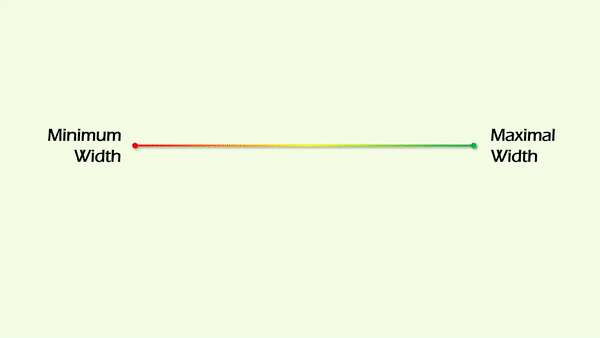
When in the settled possession phase, adhering to total minimum width can be less than practical, of course, as teams are usually organised enough defensively to deny unfettered (or at the very least repeated) access to central zones, without offering some sort of resistance. But in attacking transitions (the period immediately after a team wins the ball back and seeks to capitalise on the opposition recovering into their organised shape), minimum width is the ideal strategy; it offers a direct route to goal, where the ultimate shooting location is in a high-xG position.
Double Wide
On a tangent to the minimum width discussion, double wide is a tactical facet used by teams wherein they deploy two players in the wide zone. It’s an atypical approach, because on the contrary to the premise of minimum width, you’re allocating a large proportion of your assets to the less threatening wide zones. As outlined by the Voronoi plot below, the primary benefits are not only to generate wide overloads, but also to stretch the pitch laterally, opening passing lanes into central players.
? Bielsa's Leeds: Double Spacing to Manipulate Defensive Control
— Jamie Scott (@JamiescottUV) July 31, 2021
– Double wide on the right baits opposition across, stretching them laterally
– Double spacing in central zone offers vertical threat; Rodrigo drops to link play
– Find the side with low defensive control pic.twitter.com/dIItiRj2NC
Marcelo Bielsa was a standout user of the double wide strategy, and this notion is corroborated by his Coach ID profile, which highlights how he implemented heavy deep circulation in combination with high degrees of width, in a similar vein to the use of double wide to open progressive passing lanes above. His teams were also fairly cross heavy, as they used such width in the attacking phase too.

Staying on the topic of style of play, with regards to the coaching at Leeds United, Jesse Marsch’s radar paints a very different picture to Marcelo Bielsa’s. Jesse Marsch, naturally, being from the RB school of thought, is a massive proponent of minimum width. Again, this notion is corroborated by his Coach ID radar, which highlights how little wing play forms a priority in his Leeds United side. Quite the contrary, particularly against weaker teams, are focussed on intense (if chaotic) play, hinging on counter-pressing and the transitional phases.
This is where things get interesting, because despite significant theoretical differences, which are also highlighted by the data, Jesse Marsch’s Leeds still bear many hallmarks of a classic Bielsa team.

They do use width; in fact, they have utilised the double wide strategy more than most other Premier League teams. But how can they adhere to minimum width and the transitional benefits, while also continuing Bielsa’s use of width in such a unique way? Perhaps the answer lies in our perception of width, not the use itself.
Minimum Width & Double Wide… Simultaneously?
Leeds still use a system with the potential for width on either side when they’re building up centrally: the fullbacks flank the centre backs, positioning themselves in the inside space between the wide zone and the central zone. This positioning primes them to jump into the wide zone when an attack does develop down either side.

When play progresses down a flank, Leeds compress the far side of the pitch. They are often laterally compact in possession, seeking to play in a vertical and direct manner. Having a multitude of players shift across onto the ball-side flank typically has a propensity to congest play, however in Leeds’ case, their vertical proclivities and willingness to explore space in behind, use wall passes, and play very quick combinations, allows them to tear through defensive blocks despite the significant overload on that side.
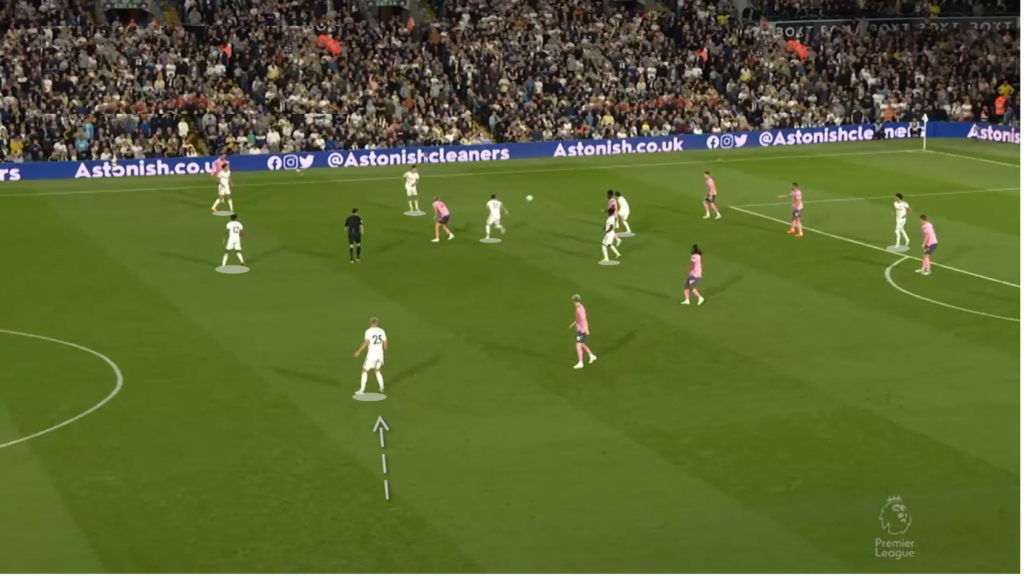
Indeed, it isn’t uncommon to see teams force their far-side players to invert when the ball is on the opposing flank; in fact, it’s generally the convention to do so. But the extent that Leeds do this to, combined with the frequency they do this, makes it somewhat of a standout. The team form a structure, almost a web of players that collapses on either flank depending on the ball’s position. By doing this, they can exhibit minimum width while having multiple players in the wide zone, simultaneously. The caveat is, that Leeds don’t view minimum width zonally. They view everything in relation to the ball position and the player positions. For them, it matters not what space is left unused on the far flank, or between the lines. What matters is that their web of players is ideally situated to progress the ball (or, as we will now discuss, press the ball).
So Leeds like to play in a narrow and direct manner, with intense, high risk, high reward vertical play. This approach is certainly conducive to losing ball possession on occasion, if not consistently. And herein lies the key benefit of this approach to Leeds; they are so well primed for transitions in this structure. As soon as a turnover occurs, they’ve got three, four, five, or more players all within a close proximity to apply pressure to the opponent in ball possession from all angles, and in immediate fashion. What is perhaps even more pertinent to discuss is how Leeds’s in possession strategy actually pins the opposition further across, meaning the opponent doesn’t have an outlet to switch the play to in most instances. For example, in the instance below, Leeds have compacted onto their left flank, and consciously or subconsciously, the Everton team have been pinned across too.
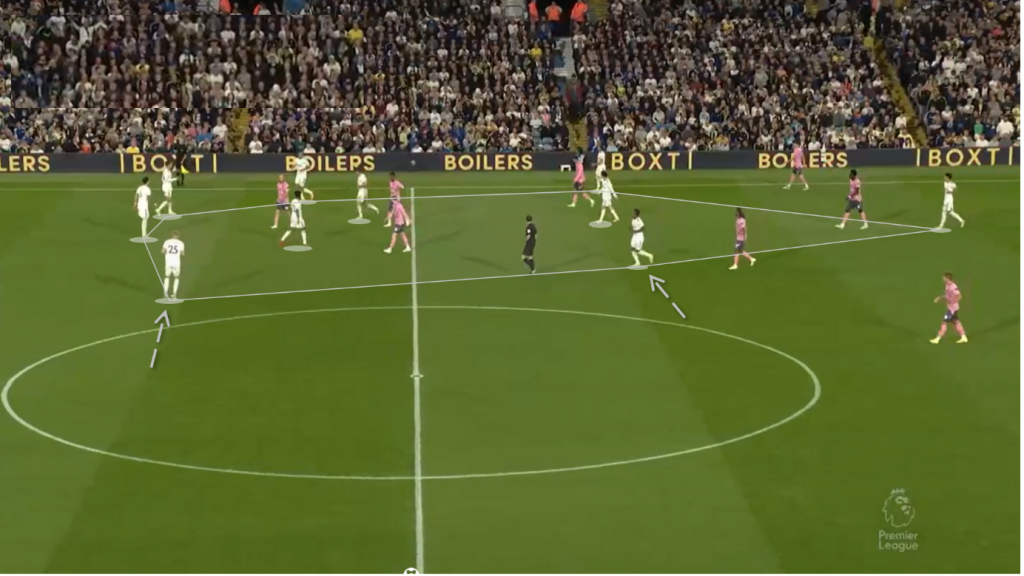
Yes, it’s a throw in, but the point remains that Everton haven’t really got an option to switch the play to. This strategy tends to drag games into a transitional dogfight, a real battle where the ball rebounds from team to team within Leeds’s compact web of control. Leeds rank highest in the Premier League for pressures in the attacking and middle third of the pitch; this is a strategy which suits them as a team, and their individuals massively.
Tyler Adams for example, is an absolutely phenomenal player at regaining possession. He ranks eighth in the league for successful pressures per 90 (minimum 3.0 90s), which is highly commendable given many of those ahead of him are forwards (including teammate and compatriot, Brenden Aaronson). If we look at how high and how effectively Adams regains possession, we can start to see the real value in Leeds’s high-intensity approach; their high-risk possession play and intense transition play have a symbiotic relationship; both ensure periods of chaos that their players are capable of handling and executing within, and both lead to Leeds generating potent chances to score from.

Furthermore, Jack Harrison is perhaps the best example of a player who benefits from this narrow, yet wide, vertically inclined approach. He is a very one footed player (left-footed), who loves to run down the line and is very explosive and alert in those transitional situations. He’s direct, picking up the ball in tight, unsettled scenarios and driving Leeds into positions to create chances.

In a similar vein to how one-footed Harrison is, he is also highly bound to the left flank, coming alive when Leeds collapse across to that side.

When his web of teammates converge on the left, he is the one who can make the runs into depth to offer an out ball after Leeds secure possession, but equally he can be the one to dribble and execute passes/crosses out of the congestion and into scoring areas.
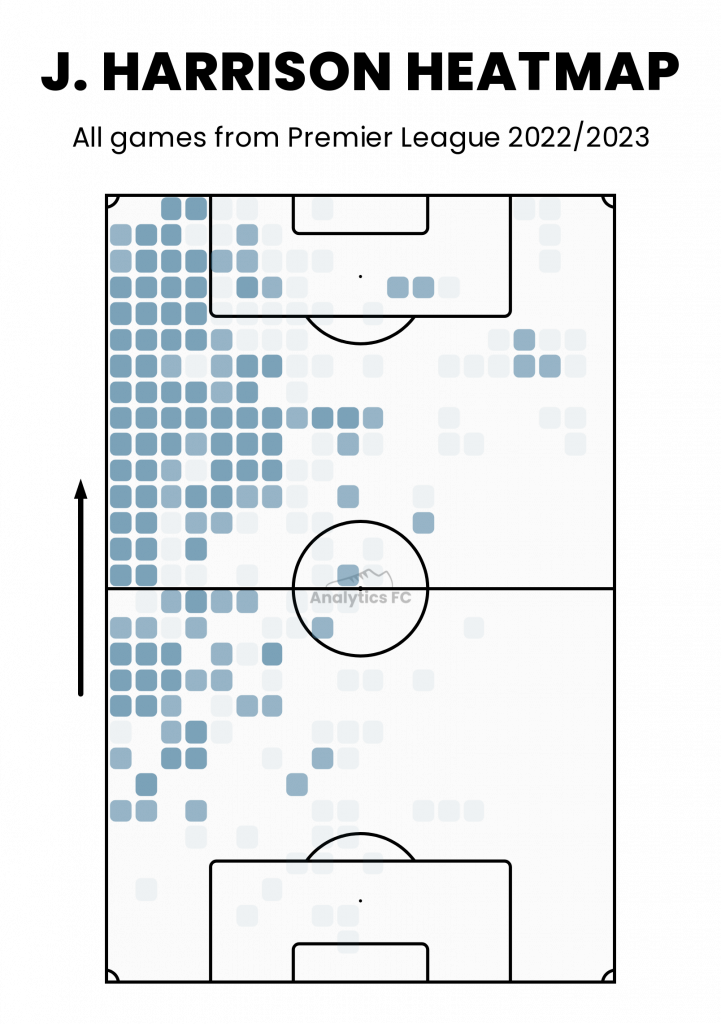
Naturally, his season heatmap is quite noisy, such is the dynamic nature of Leeds’s approach to positioning, but his proclivity for the left flank is clear to see. With his teammates compacting from the other side, Harrison is a perfect individual to highlight how Leeds exploit with while exhibiting minimum width themselves.
Discussion and Conclusion
Leeds’s approach is highly optimised for their squad. With a core of players who have been present from the Bielsa era, and smart acquisitions under Marsch, including three RB players (Aaronson, Adams, and Kristensen), focussing their game around extended transition phases and quick vertical play suits Leeds to a tee. Utilising a very narrow structure in possession, and being able to mesh it with the use of double width, creates the game states that suit Leeds. They know they can kill most opponents with their intensity, having their web of athletic players in such a close proximity to the ball, allowing them to counter-press so efficiently. The security that having this counter-pressing game offers is that Leeds can play a high-risk progression game, with lots of ambitious vertical balls.
Furthermore, with players like Aaronson, who is such a quick dribbler, even in congested areas, and Harrison, who is so direct and effective down the left, Leeds can often capitalise from the chaos they induce. This is particularly the case when they’ve pinned the opposition right across the pitch, because Leeds can then attack the spaces around the box when they escape the pressure. The main beneficiary from an output standpoint is Rodrigo, who in typical ‘minimum width fashion’, has been able to take all his shots in the 2022/23 season from inside the width of the penalty box.

It is therefore no surprise that Rodrigo ranks fourth in the league for xG per 90 (minimum 3.0 90s) at this stage, with 0.60, behind only Erling Haaland, Aleksandar Mitrovi?, and Harry Kane.
As a point of discussion, it is worth noting that Leeds’s approach is scarcely different to Liverpool’s approach in the way that they view the interplay between ambitious, high-risk passing and counter-pressing to ensure they regain possession in the event of ball loss. Leeds merely use the combination of double wide and minimum width, while Liverpool use more of a zonally-aware approach.
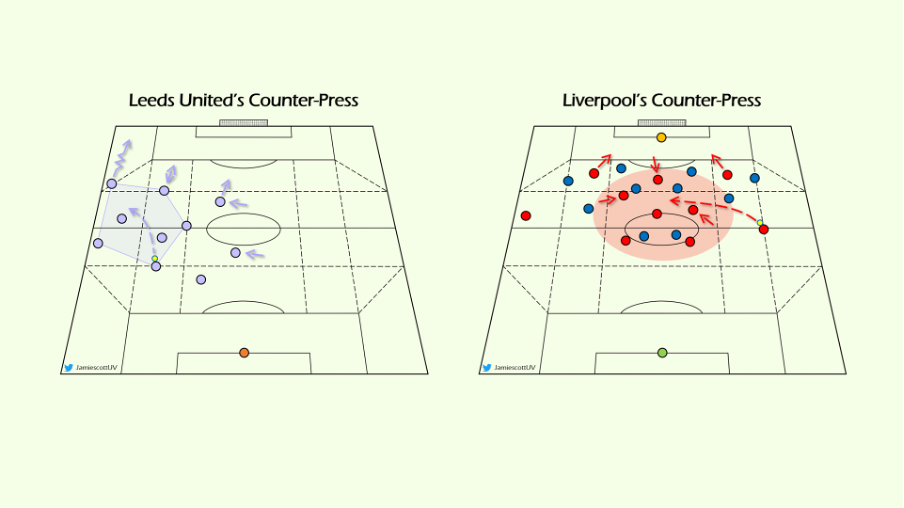
The juxtaposition between double wide and minimum width posits an interesting headline for discussion, but one could say whether you view width from a zonal or player-centric perspective is just a point of semantics.
Leeds United view the game of football, and subsequently player positioning, in relation to the opposition and the ball. They drag their opponents into unwanted areas, before deploying their hard to handle approach – which incidentally optimises their players’ strengths. Moving forwards, the question is, can Leeds United sustain this approach, and if so, how far can it take them?













